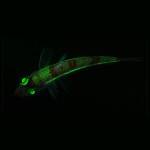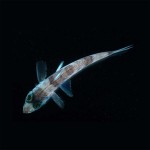Fish eyes go green
Scientists find a surprise in the lens of a fish that lives in the dark

By the light of day, a greeneye fish seems ordinary: It has a long, narrow body and a small head topped with large, upward-glancing eyes. But if you cut out the bright lights and turn on a dim blue-violet bulb, those eyes glow with an eerie, green hue. That’s because their lenses are fluorescent, which means they absorb one color of light and emit another.
Scientists are now beginning to understand the advantages this gives the species.
If you’re a fish that sees mostly green, a lens that changes another color to green might help you see more predators and prey. For humans, who live in a world of many colors, this kind of lens would make life very confusing. But greeneye fish live 160 to 3,300 feet (49 to 1,006 meters) below the surface, a dark depth that’s home to lots of animals that glow blue-violet. Greeneyes’ color-change lenses allow them to see these blue-violet animals.
Yakir Gagnon, a biologist from Duke University in Durham, N.C., helped identify the greeneye fish’s color-altering vision system. He and his colleagues presented their findings at a recent meeting of biologists in Charleston, S.C.
Light travels as waves, and each wave’s length varies based on the color of light. (A wavelength is the distance between two peaks, or two valleys, in the wave.) Red light has longer wavelengths than yellow light; red’s and yellow’s are longer than green’s. Violet light has the shortest wavelength among colors we can see. Light with waves shorter than violet are called ultraviolet and invisible to the naked eye.
Lenses of the eye, in fish as in people, focus incoming light onto the retina, a light-sensitive layer at the back of the eyeball. The retina sends signals to the brain, which composes an image. Humans detect several different colors of visible light. That’s not true for the greeneye fish, which detects mostly a particular hue of green light.

When the Duke scientists shined blue-violet light on the fish lens, it flashed blue-green. Wavelengths of that glow were just a shade shorter than the green hue that this fish sees best.
This project began when biologist Alison Sweeney, a former graduate student at Duke who is now at the University of California, Santa Barbara, shone blue-violet light on a greeneye’s lens and found that that it sent a blue-green image to the retina. The Duke team also found that the light doesn’t change direction as it passes through the fish eyes. That’s surprising because fluorescent substances usually glow all over and aren’t able to beam light in specific directions.
The experiments suggest that the glowing lens of the greeneye fish offers benefits to the animal, but scientists don’t yet know exactly how the vision system works.
“This is all too new,” Gagnon told Science News.
POWER WORDS (adapted from the New Oxford American Dictionary)
retina A layer at the back of the eyeball containing cells that are sensitive to light and that trigger nerve impulses that travel along the optic nerve to the brain, where a visual image is formed.
lens The transparent elastic structure in the eye, behind the iris, by which light is focused onto the retina of the eye.
ultraviolet Having a wavelength shorter than that of the violet end of the visible spectrum.
wavelength The distance between successive crests of a wave.







